Sunday, March 19, 2023
3 Ingredients to A Successful Business
Protecting Children in a Digital Age

Keeping a watchful eye on your kids requires an increasing level of tech savvy many parents find intimidating. Not only are your kids vulnerable to bad actors online, but your family’s personal information could be at risk, as well.
Learn how to protect your children and family in this digital age with these tips:
Elementary-Age Children
- Encourage open communication. Have conversations about what your kids see and do online and talk with them about potential dangers. Avoid lecturing in favor of an open exchange of information.
- Make their inherent interest in privacy work in your favor. Kids in this age group, particularly toward the middle school years, understand the concept of privacy and value it immensely. Use that context to help them understand what goes online is there to stay. Talk about what kinds of information should always be kept private, including identifying details like addresses and social security numbers.
- Stay on alert. Not all apps are completely safe (even the ones you can access from trusted stores) and not all filters are foolproof. Keep close tabs on what your kids are downloading by reading comments and reviews, and regularly monitoring what kind of content they see.
Middle School and High School Kids
- Continue talking about privacy. You can never have too many conversations about privacy. What seems like harmless sharing on social media can be quite revealing. For example, frequent posts about visits to a favorite store or restaurant can allow a predator to begin tracking behavior patterns that make your child a target. It’s also important for kids to understand how their privacy settings work. For example, settings that allow exposure to friends of friends make their visibility to strangers much broader than they may realize.
- Help manage their online reputation. Behaviors that once resulted in a day or two of hallway chatter can now live forever. Documenting mischief online is only fun until it spills over into real life and everyone sees those mistakes in full color – including prospective future employers.
- Be clear about your position on bullying. From the safe distance of a screen, it’s easier for kids (and adults) to say things they’d never say in person. Teach your kids to handle problems constructively offline and avoid engaging in attacks on others through social media, email and other platforms.
College Students
- Reinforce the risks. Once they’re on their own, kids may feel more liberated to make their own choices online. However, college students are easy prey for identity theft and worse. Remind them what’s at stake if they fail to protect their identity and private information, like where they live and what they do on a regular basis.
- Teach smart practices. With all the independence that comes with college life, this is an ideal time for your student to take personal responsibility for his or her online security, including learning about virus protection, updating software, avoiding scams and backing up data.
If you’re looking for more practical advice for everyday family matters, visit eLivingtoday.com.
Family Features
Top 5 Smartphone Features You Can’t Live Without
River Cruises Offer Exploration, Comfort

Travel for pure enjoyment is on the rise, so this may be your year to plan the ultimate dream vacation.
According to Sports and Leisure Research, 80% of people surveyed believe a vacation does wonders for mental health and travel is a top spending priority in the coming year. The survey indicated travelers want to immerse themselves in unique experiences, including new cultures, foods and people.
 For those who delight in exploring entire regions, one downfall can be the burden of packing and unpacking at each new destination. Taking your accommodations with you is a practical alternative for curious travelers.
For those who delight in exploring entire regions, one downfall can be the burden of packing and unpacking at each new destination. Taking your accommodations with you is a practical alternative for curious travelers.
River voyages, for example, allow travelers to unpack once and visit multiple destinations in one seamless journey, from major European cities to quaint towns and villages. These destination-focused journeys offer experienced travelers the opportunity to explore science, history and cuisine with culturally enriching itineraries on the world’s great waterways.
If an intimate, relaxed journey is your ideal getaway, you may want to consider the revolutionary Viking Longships. These state-of-the-art river ships are engineered with guests’ comfort and exploration in mind.
Sailing Europe’s storied rivers, the award-winning fleet of identical longships showcase innovative engineering, streamlined Scandinavian design and understated elegance. River ships are also small enough – hosting 190 guests – to dock in the heart of popular destinations, making it easy to explore.
The voyages range from 8-23 days with itineraries featuring Europe’s Rhine, Main, Danube, Seine, Rhône, Douro, Moselle, Elbe, Dordogne, Garonne and Gironde Rivers.
Known as travel experiences for “The Thinking Person,” each Viking journey includes a shore excursion in every port and an onboard and onshore enrichment program that provides deep immersion in the destination through performances of music and art, cooking demonstrations, informative port talks and carefully selected guest lecturers. Enjoy shore excursions that provide historical tours and visits to unique haunts where you can experience some of the local culture, regional foods and everyday life.
On a Viking Longship, you can expect to relax in spacious public areas, including wide-open sun decks with ever-changing views. The ships feature spacious staterooms in a variety of categories, including true two-room suites with full-size verandas.
Additional ship highlights include al fresco dining on an indoor-outdoor terrace and onboard amenities including a restaurant, bar, lounge and library. Inclusive fares that cover your port taxes and fees also mean you can enjoy beer, wine and soft drinks with onboard lunch and dinner; specialty coffees, teas; bottled water; ground transfers; and more.
Chart your next adventure at viking.com.
Viking River Cruises
Dishing Out the Facts on Good Fats
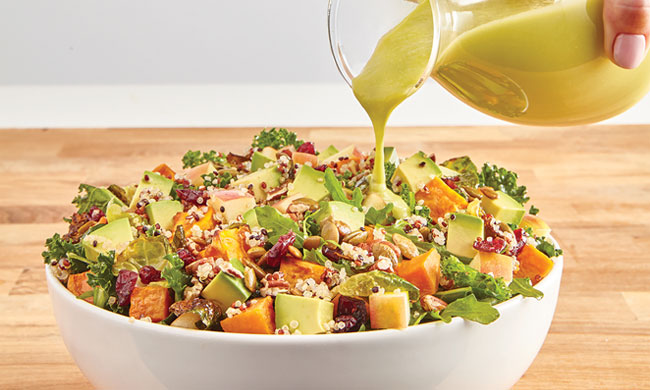
For those seeking to be more health-conscious, the idea of eating nutritiously seems simple. However, understanding what’s truly “good for you” can sometimes be confusing.
In honor of National Nutrition Month and Healthy Fats Day in March, Avocados From Mexico is sharing how avocados – a super good food and source of good fats and several vitamins – make everything better. Avocados From Mexico conducted a survey and found that while 76% of respondents believe fat is an essential component of a healthy diet, less than one-third are confident they know why it’s important to have “good fats” in their diets.
For starters, according to the survey, nearly half of Americans didn’t realize foods with good fats, like avocados, can help with weight management. However, monounsaturated and polyunsaturated fats found in avocados can lower the risk of becoming overweight, according to research published in “Nutrients.”
 “Most people are aware of the Mediterranean Diet, but nearly half (40%) of survey respondents didn’t realize that this eating pattern does not limit fat coming from plantsources like avocados,” said nutrition expert and registered dietitianBarbara Ruhs. “These types of unsaturated good fats are also recommended by the American Heart Association for heart health. Eating avocados in place of foods containing saturated fat is an easy and delicious way to approach healthy eating.”
“Most people are aware of the Mediterranean Diet, but nearly half (40%) of survey respondents didn’t realize that this eating pattern does not limit fat coming from plantsources like avocados,” said nutrition expert and registered dietitianBarbara Ruhs. “These types of unsaturated good fats are also recommended by the American Heart Association for heart health. Eating avocados in place of foods containing saturated fat is an easy and delicious way to approach healthy eating.”
Virtually the only fresh fruit with good fats, avocados can help people meet both good fat and fruit and vegetable recommendations in the same bite with approximately 6 grams of good fats per serving (one-third of a medium avocado). They are nutrient-dense, making avocados a superfood with super benefits. Avocados are also free of cholesterol and sodium and have nearly 20 vitamins and minerals.
Another finding from the survey is that while people believe fat is essential to a healthy diet, one-third of survey respondents believe saturated and trans fats are associated with health benefits, indicating confusion about the various types of fats. Many Americans need to balance their overall fat intake by reducing “bad” or saturated fat intake and increasing “good” or unsaturated (monounsaturated and polyunsaturated) fat intake. Replacing saturated fats with unsaturated fats can help reduce LDL, or bad cholesterol levels.
Dietary fat helps the body absorb vitamins A, D, E, and K. These vitamins are fat soluble, which means they can only be absorbed by the body with the help of fats. Per one-third of a medium avocado (50 grams), avocados contribute 6 grams of unsaturated fats, which are known to be essential for normal growth and development of the central nervous system and brain.
Make good fats a part of your next trip to the grocery store with this avocado-inspired Harvest Bowl Salad with Balsamic Vinaigrette certified by the American Heart Association.
To find more nutritional facts and figures, along with recipes featuring the superfood, visit AvocadosFromMexico.com.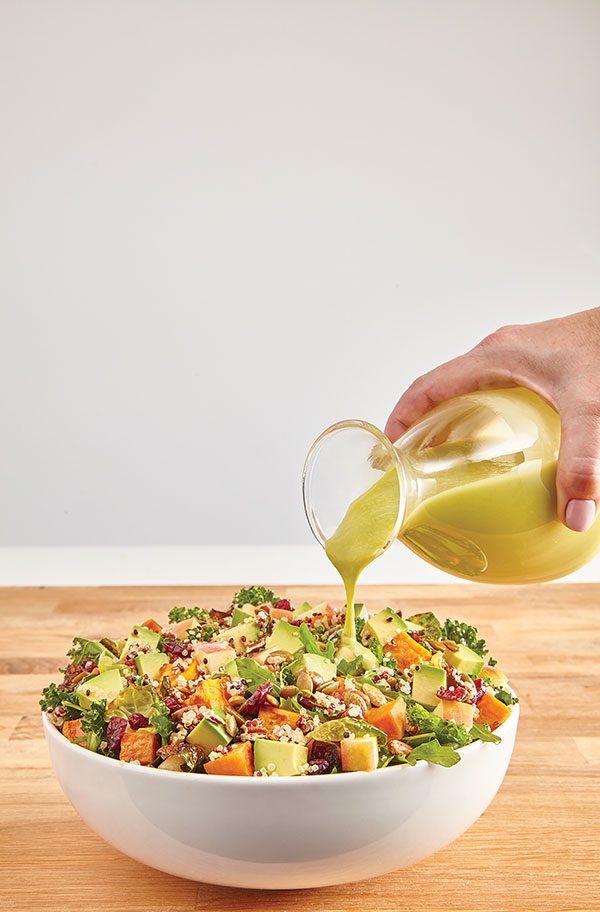
Harvest Bowl Salad with Balsamic Vinaigrette
Servings: 8
Balsamic Vinaigrette:
- 1/2 Avocado From Mexico, diced
- 1 tablespoon avocado oil
- 2 tablespoons shallots, minced
- 1 tablespoon Dijon mustard
- 3 tablespoons white balsamic vinegar
- 1 tablespoon honey
- 3 tablespoons water
Salad:
- 2 Avocados From Mexico, diced
- 2 sweet potatoes, roasted and diced
- 2 cups quinoa, cooked
- 2 cups arugula
- 2 cups kale
- 1 cup Brussels sprouts petals, roasted
- 2 Honeycrisp apples, diced
- 2 tablespoons roasted pecans, unsalted
- 2 tablespoons roasted pepitas, unsalted
- 2 tablespoons dried cranberries
- To make balsamic vinaigrette: In food processor, process avocado, avocado oil, shallots, Dijon mustard, balsamic vinegar, honey and water to smooth consistency. Set aside.
- To make salad: In large bowl, combine avocados, sweet potatoes, quinoa, arugula, kale, Brussels sprouts petals, apples, pecans, pepitas and dried cranberries. Pour balsamic vinaigrette over salad mixture.
- Toss salad to coat. Keep refrigerated until ready to serve.
Nutritional information per serving: 390 calories; 16 g total fat; 0 g saturated fat; 0 g cholesterol; 370 mg sodium; 55 g total carbohydrates; 11 g dietary fiber; 12 g sugar; 15 g protein.
Avocados From Mexico
Saturday, March 18, 2023
10 Affordable Ideas to Boost Curb Appeal

Your home’s first big impression is its curb appeal, so if your place is in need of some sprucing up, you may wonder how you can make some updates without breaking the bank.
These 10 ideas are easy on budgets, but they can also make a big impact on your home’s exterior image.
- Paint your front door. As long as your front door is in good condition, there’s no need to replace it completely. A fresh coat of paint can instantly update your home’s facade. Go bold or stick with a classic hue – it’s all up to you.
- Dress up the windows. Add character and charm by enhancing your front windows. You might add wooden shutters, window box planters or both. Also look at the trim around the windows. If it’s chipped and peeling, adding a fresh coat of paint doesn’t just look nice, it can protect your windows from damage, too.
- Clean up flower beds. An unkempt flower bed can drag down an otherwise stunning home. Keep beds tidy and vegetation trimmed, even during the offseason. Watch for weeds and replenish mulch or rock ground cover as needed to keep the beds looking healthy and inviting.
- Install new lighting. Replacing outdated light fixtures can give your exterior an instant upgrade. There’s no right or wrong style; just choose a color and look that matches the rest of your design.
- Replace worn welcome mats. A cheerful mat at your front door can be an inviting sight for visitors, but those mats inevitably wear with time, and what was once bright and charming becomes dingy and dull. A new mat can help bring back that cheery entry you once cherished.
- Pressure wash the drive and walk. Over time, driveways and sidewalks collect an incredible amount of grime. Pressure washing not only eliminates the filth, but the clean surfaces also add to your home’s visual appeal.

- Add new vegetation. Landscaping is a relatively inexpensive way to introduce more personality to a yard. Aim for a mix of pretty and practical, such as some low flowering bushes and some trees or bushes that offer privacy and shade.
- Keep up with basic maintenance. When your home is in poor repair, it shows. Pay attention to bent or rusting gutters, imperfections in the roof and other maintenance matters that aren’t just aesthetic; left unrepaired, they can also result in major damage.
- Pay attention to details. Functional items like the mailbox might not seem like much of a design element, but these small details can be a big distraction if they’re not in good condition. Update or replace as needed to keep your aesthetic in sync.
- Add seasonal decor. There’s no need to go all out for every occasion, but some timely decorations that celebrate the holiday or season can make your entry fun and festive. Coordinate wreaths, planters, signs and other accent pieces for a cohesive look that says, “come on in.”
Find more affordable ideas for upgrading your home and garden at eLivingtoday.com.
Photo courtesy of Unsplash
Family Features
Thursday, March 16, 2023
Finding joy in the darkness: A teenage cancer patient's story of hope, family and an amazing trip
A Hoppy Easter Cake

(Culinary.net) Warmer days at the start of spring mean Easter is almost here, and the big bunny himself will be hopping around in no time delivering goodies.
This Easter, celebrate with your loved ones with a delicious and colorful Easter Bunny Butt Cake. It can bring smiles and laughter while putting everyone in a light, joyful mood.
This cake is fun and bright with a fluffy, moist interior. Complete with chocolate candy eggs, shredded coconut and chocolate chips for little bunny toes, this recipe goes all out to paint a picture of the Easter bunny.
Start by combining whole eggs, egg whites, cream of coconut, crushed pineapple, coconut extract and vanilla extract.
In a food processor, pulse flour, sugar, baking powder and salt. Then add butter gradually, 6 tablespoons at a time, for a total of 12 tablespoons.
Add dry mixture to a mixing bowl then add egg mixture half at a time. Beat until cake batter is formed.
Fill muffin tins 2/3 full and bake 18-20 minutes. The remaining batter goes into an oven-safe bowl to bake for 1 hour, 40 minutes.
The buttercream frosting is made with powdered sugar, butter, milk, vanilla extract and coconut extract.
Assemble the cake using pretzel sticks to blend it together to make the bunny butt shape. Frost the cake and spread shredded coconut over it to create a textured appearance. Stick chocolate chips on the bunny’s feet to create toes. Place your favorite Easter or bunny candies around the cake for extra garnish.
This cake is worth every step. It’s delicious and as cute as can be, plus it’s perfect for dessert after a big Easter dinner.
Find more creative and scrumptious holiday recipes at Culinary.net.
Watch video to see how to make this recipe!

Easter Bunny Butt Cake
Servings: 10-12
- Nonstick cooking spray
- 2 eggs, plus 4 egg whites, at room temperature
- 3/4 cup cream of coconut
- 1/2 cup crushed pineapple, drained
- 2 teaspoons coconut extract
- 1 teaspoon vanilla extract
- 2 1/4 cups flour
- 1 cup sugar
- 2 teaspoons baking powder
- 1/2 teaspoon salt
- 12 tablespoons unsalted butter, at room temperature
Buttercream Frosting:
- 3 cups powdered sugar
- 2 sticks unsalted butter, softened
- 3 tablespoons milk
- 1 teaspoon vanilla extract
- 1/2 teaspoon coconut extract
- 4 thin pretzel sticks
- 1 bag (10 ounces) sweetened shredded coconut
- 8 drops green food coloring
- 2 large round chocolate candy melts
- 6 chocolate chips
- mini candy-coated chocolate eggs, for garnish
- Heat oven to 325 F.
- Line muffin pan with four paper liners. Spray oven-safe glass bowl with nonstick cooking spray.
- In large bowl, whisk eggs, egg whites, cream of coconut, pineapple, coconut extract and vanilla extract until combined.
- In food processor, pulse flour, sugar, baking powder and salt until combined. Add 6 tablespoons butter. Pulse until combined. Add remaining butter. Pulse until coarse meal forms.
- In large mixing bowl, add coarse flour butter meal. Add half of egg mixture. Beat 1-2 minutes. Add remaining egg mixture; beat until combined.
- Fill each muffin cup 2/3 full. Bake 18-20 minutes, or until done. Cool completely.
- Pour remaining batter into prepared oven-safe bowl. Bake 1 hour, 40 minutes, or until done. Cool completely.
- To make buttercream frosting: In large bowl, add powdered sugar and butter; beat until fluffy. Add milk, vanilla extract and coconut extract; beat until creamy.
- Turn bowl upside-down on cake stand until cake removes from bowl. If cake needs leveled, turn cake over and trim to flatten. Frost cake.
- Remove wrappers from cupcakes. Using two pretzel sticks, press into base of cupcakes
- and anchor to bottom rim of bowl cake to create bunny feet. Frost feet.
- Take third cupcake and cut muffin top off. Cut muffin top in half. Using one pretzel stick, anchor one muffin top half at bottom of full cupcake to form toes. Repeat with second muffin top half for other foot. Frost toes.
- Attach final cupcake with remaining pretzel stick to butt area of cake to make tail. Frost tail.
- Apply 1 1/2 cups shredded coconut all over cake. Press chocolate candy melts into bottoms of bunny feet to resemble foot pads. Add chocolate chips to resemble pads for toes.
- Place remaining coconut in plastic bag. Add green food coloring. Toss in bag until coconut is colored. Spread around base of cake for grass. Decorate grass with chocolate eggs.
Tips: Spoon flour into dry measuring cup and level off excess. Scooping directly from bag compacts flour, resulting in dry baked goods. Add 1 tablespoon additional milk if frosting is too stiff. Keep adding until desired consistency.
Culinary.net
Tuesday, March 14, 2023
What Women Need to Know About Stroke Risks

It may not be widely known that women face unique risk factors for stroke throughout their lifetime. Things like pregnancy, preeclampsia and chronic stress can increase the risk for high blood pressure, a leading cause of stroke.
Cardiovascular disease, including stroke, is the leading cause of death among women, according to the Centers for Disease Control and Prevention (CDC), and 1 in 5 women will have a stroke. However, a large majority of strokes can be prevented.
Caring for yourself by understanding your risk factors can help reduce your risk for stroke and provide a better quality of life. Start managing your stroke risk with these tips from the American Stroke Association, a division of the American Heart Association:
Monitor Your Blood Pressure
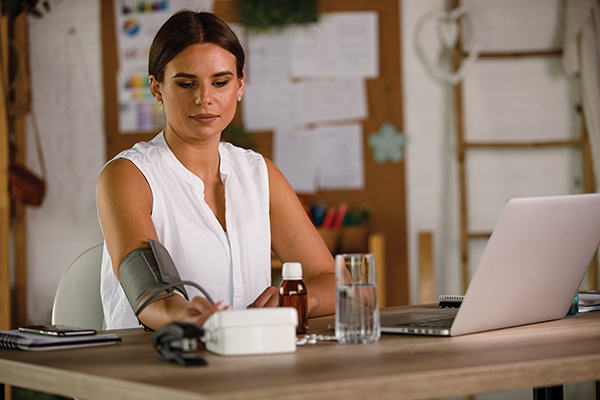 The first step you can take in reducing your risk for stroke is knowing your blood pressure and keeping it in a healthy range. High blood pressure is the No. 1 preventable cause of stroke, according to the American Heart Association.
The first step you can take in reducing your risk for stroke is knowing your blood pressure and keeping it in a healthy range. High blood pressure is the No. 1 preventable cause of stroke, according to the American Heart Association.
The best way to know your blood pressure is to have it measured at least once per year by a health care professional and regularly monitor it at home then discuss the numbers with a doctor. For most people, a normal blood pressure should be 120/80 mm HG or less.
In addition to properly monitoring blood pressure, maintaining a healthy weight, being physically active, eating healthfully and reducing or eliminating alcohol and tobacco usage can help control blood pressure. If you do develop high blood pressure, work with a health care professional on a plan to help manage it.
Plan for Pregnancy
In the United States, high blood pressure during pregnancy is becoming more common, according to the CDC, and medical conditions including preeclampsia, gestational diabetes and blood clots during pregnancy all increase stroke risk during and immediately following a pregnancy.
Managing conditions like high blood pressure before getting pregnant helps keep you and your baby healthy during pregnancy and beyond. In addition, your health during and immediately after a pregnancy can shape the lifelong health of you and your child. If you’re planning to become pregnant or are currently pregnant, it’s important to regularly monitor your blood pressure.
Take Care of Your Mental Health
Some stress is unavoidable but constant stress is not healthy. Chronic or constant stress may lead to high blood pressure and other unhealthy behavior choices, which can increase risk for stroke.
Based on findings in a Stress in America 2020 survey conducted by the American Psychological Association, the top sources of stress are money, work, family responsibilities and health concerns. Managing your stress and blood pressure can improve your overall health and well-being. Reclaim control of your schedule and build in time to invest in your health. Find 10 minutes every day to do something for you, like listening to music, meditating or going for a walk.
Learn the Warning Signs
A stroke can happen to anyone at any point in life. Immediate treatment may help minimize the long-term effects of a stroke and even prevent death. Learn how to spot a stroke F.A.S.T:
- Face drooping – Does one side of the face droop or is it numb? Ask the person to smile. Is the person’s smile uneven?
- Arm weakness – Is one arm weak or numb? Ask the person to raise both arms. Does one arm drift downward?
- Speech difficulty – Is speech slurred? Is the person unable to speak or hard to understand? Ask the person to repeat a simple sentence like “The sky is blue.”
- Time to call 911 – If someone shows any of these symptoms, even if the symptoms go away, call 911 and get to a hospital immediately. Check the time so you’ll know when the first symptoms appeared.
Talk to your doctor about ways to improve your well-being and help prevent stroke. Find more wellness tips at stroke.org.
American Stroke Association
5 pasos para controlar adecuadamente la presión arterial

Casi la mitad de los adultos estadounidenses tienen presión arterial alta o hipertensión, según los Centros para el Control y la Prevención de Enfermedades. De ellos, alrededor del 75% no lo tienen bajo control, y es posible que muchos ni siquiera se den cuenta de que lo tienen a menos que experimenten otras complicaciones.
De hecho, la hipertensión es una de las principales causas y un factor de riesgo controlable de enfermedades cardíacas y accidentes cerebrovasculares, así como de otros problemas, como insuficiencia renal, pérdida de la visión y problemas sexuales. Sin embargo, la Asociación Americana del Corazón recomienda seguir estos sencillos pasos para ayudar a controlar sus niveles y manejar los riesgos.
1. Conozca sus números
En la mayoría de los casos, la presión arterial normal es de 120/80 mm HG o menos. Las lecturas consistentemente superiores a 130/80 se consideran presión arterial alta. Pida a un profesional de la salud que le mida la presión arterial al menos una vez al año y contrólela regularmente en su casa con un monitor validado y luego discuta las lecturas con su médico. Obtener lecturas precisas puede ayudar a garantizar el tratamiento más adecuado en caso de que surja algún problema.
2. Mantenga un peso saludable
Si tiene sobrepeso u obesidad, tiene un mayor riesgo de hipertensión. Perder solo el 3-5% de su peso corporal puede ayudar a mejorar sus números. Hay una gran cantidad de planes y programas disponibles que pueden ayudar con la pérdida de peso, y tomar medidas positivas con un amigo o familiar puede ayudar con la motivación.
3. Manténgase activo
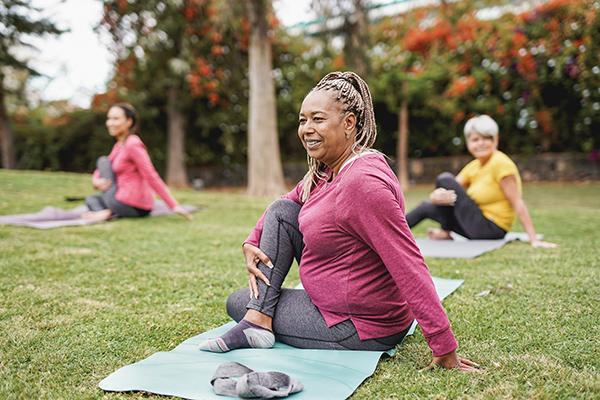 Para maximizar los beneficios para la salud y ayudar a mantener la presión arterial en el rango normal, la Asociación Americana del Corazón recomienda que los adultos realicen al menos 150 minutos por semana de actividad moderada, 75 minutos de actividad intensa o una combinación de ambas. Pruebe actividades como caminar a paso ligero, nadar, montar en bicicleta o bailar. Por ejemplo, la campaña Get Down with Your Blood Pressure usa música y baile para ayudar a recordar los cuatro sencillos pasos para autocontrolarse la presión arterial:
Para maximizar los beneficios para la salud y ayudar a mantener la presión arterial en el rango normal, la Asociación Americana del Corazón recomienda que los adultos realicen al menos 150 minutos por semana de actividad moderada, 75 minutos de actividad intensa o una combinación de ambas. Pruebe actividades como caminar a paso ligero, nadar, montar en bicicleta o bailar. Por ejemplo, la campaña Get Down with Your Blood Pressure usa música y baile para ayudar a recordar los cuatro sencillos pasos para autocontrolarse la presión arterial:
- Tómelo: tome su dispositivo de autocontrol de la presión arterial (SMBP, por sus siglas en inglés)
- Deslícelo: deslice el brazalete SMBP hacia arriba de su brazo
- Envuélvalo: envuelva el brazalete cómodamente, pero no demasiado apretado
- Compruébelo: compruebe su presión arterial en el dispositivo
4. Aliméntese bien
Hacer cambios pequeños y simples en sus hábitos alimenticios puede ser de gran ayuda para que usted y su familia se mantengan saludables. Comer frutas y verduras, como mangos, aguacates y arándanos, puede reducir la presión arterial con el tiempo. Otras opciones inteligentes incluyen frutos secos y semillas, cereales integrales, proteínas magras y pescado.
5. Disminuya el consumo de alcohol y tabaco
Fumar agrava los factores de riesgo de las enfermedades cardíacas, como la presión arterial alta y la diabetes, y las sustancias químicas del humo del tabaco pueden dañar el corazón y los vasos sanguíneos. Asimismo, el consumo excesivo de alcohol (más de dos copas al día) se asocia con la hipertensión arterial. Limitar el consumo de alcohol y dejar de fumar, o evitar el humo de segunda mano, puede ayudar a reducir el riesgo.
Si desarrolla hipertensión, trabaje con un profesional de la salud para controlarla y visite heart.org/hbpcontrol para encontrar recursos locales para la presión arterial, videos de autocontrol paso a paso y más.
Control de su presión arterial en el hogar
Es importante saber cómo controlar correctamente su presión arterial, especialmente si su médico recomienda un autocontrol regular en casa.
- Quédese quieto. No fume, tome cafeína ni haga ejercicio durante los 30 minutos antes de medir su presión arterial. Vacíe su vejiga y tómese al menos 5 minutos de descanso tranquilo antes de medir.
- Siéntese correctamente. Siéntese con la espalda recta y apoyada. Mantenga los pies apoyados en el suelo y las piernas sin cruzar. Apoye su brazo sobre una superficie plana, como una mesa, con su bíceps al nivel del corazón. Coloque la parte inferior del brazalete directamente sobre el pliegue de su codo. Nunca tome medidas sobre las mangas u otra ropa.
- Mida a la misma hora todos los días. Para una mayor consistencia, tome lecturas a la misma hora todos los días, por ejemplo, a una hora determinada por la mañana y por la noche.
- Tome varias lecturas y registre los resultados. Cada vez que mida, tome 2-3 lecturas con aproximadamente 1 minuto de diferencia y registre los resultados para compartirlos con su médico.
Este proyecto cuenta con el apoyo de acuerdos cooperativos (CPIMP211227 y CPIMP211228) con la Oficina de Salud de las Minorías (OMH) del Departamento de Salud y Servicios Humanos (HHS) de EE. UU., como parte de una asignación de asistencia financiera por un total de $14.6 millones de dólares en colaboración con la Administración de Recursos y Servicios de Salud (HRSA). El contenido no necesariamente representa las opiniones oficiales de la OMH, la OASH, el HHS ni del Gobierno de EE. UU., ni estos organismos respaldan dicho contenido. Para obtener mayor información, visita https://www.minorityhealth.hhs.gov/.
American Heart Association
Fun Easter 'Egg-turnatives'

4 creative alternatives to decorating eggs this Easter
While decorating eggs for Easter is a tradition that dates back centuries, the high cost of eggs may make it more difficult for some families this year. However, that doesn’t mean you can’t find creative ways to keep the season special and create memories with loved ones.
With more than 140 years of experience, the Easter egg decorating experts at PAAS® are sharing some ideas and inspiration on fun things to do with your Easter decorating kit. These “egg-citing” alternatives to using traditional eggs can help keep those simple moments of connection and creativity alive:
Pretty in Plastic
 Dyeing plastic eggs is an activity perfect for all ages with less stress and less mess since they don’t crack or break when dropped. Dyeable plastic eggs also typically come in packages of more than a traditional dozen, offering more opportunities for creativity. Another added bonus: You can decorate your home every year with the finished product since they don’t go bad. They are also perfect for DIY projects, such as making them into garland, hanging ornaments, place settings or gifts that can be used for years to come.
Dyeing plastic eggs is an activity perfect for all ages with less stress and less mess since they don’t crack or break when dropped. Dyeable plastic eggs also typically come in packages of more than a traditional dozen, offering more opportunities for creativity. Another added bonus: You can decorate your home every year with the finished product since they don’t go bad. They are also perfect for DIY projects, such as making them into garland, hanging ornaments, place settings or gifts that can be used for years to come.
Baked Easter Decor
Instead of buying eggs, you can make your own baking soda dough eggs using 1/2 cup corn starch, 1 cup baking soda and 3/4 cup water. Combine the ingredients, roll into egg shapes and bake in the oven for 1 hour at 175 F then simply dye them as you would real eggs using your favorite PAAS egg decorating kit. Fun for all ages, these eggs can be turned into a variety of decor and mementos with kids taking the lead on mixing the dough batter and shaping the eggs before an adult helps with the baking.
Creative Kitchen Canvases
Coffee filters are good for more than just making coffee; they make perfect canvases for Easter decorating and naturally take dye. With 100-250 coffee filters per package, they’re a cost-effective way to maximize crafting opportunities and let creativity run wild. Once dyed and dried, you can turn the filters into flower centerpieces, papier mache eggs, artwork to frame and more.
Repurposed Treasure from Nature
Kids often love to hunt for fun-shaped and colorful rocks when exploring outdoors or collect seashells while on vacation or taking a walk on the beach. Now, rather than storing them in a “treasure box” or throwing them back outside, they can be creatively decorated for Easter using paint, stickers, glitter, accessories and other add-ons. Some seashells can even be dyed. Using rocks and shells of all shapes and sizes is a cost-effective, low-waste alternative that allows children to use their imaginations for creative play once they’re done decorating.
For more tips and ideas to make Easter “eggstra” special this year, visit paaseastereggs.com.
Sustainable Tips to Avoid Egg Waste
If you plan to keep the tradition of dyeing eggs alive this year, you can take steps to avoid food waste once you’re done decorating. Consider these sustainable tips from the experts at PAAS:
- Make Deviled Eggs: As long as you refrigerate the eggs shortly after dyeing them, you can use them to make deviled eggs – an Easter brunch staple – for your family meal.
- Create Centerpieces: Dyed eggs can be used to make a beautiful centerpiece for your family dinner. Simply spread them over your table runner around other decor, fill a glass bowl or jar with the eggs or place them within a floral arrangement to add pops of color to the table.
- Serve a Salad: Eating the eggs saves you from food waste, and eggs can be used in a variety of salads, including egg salad, potato salad or chef’s salad, to add a boost of protein and flavor.
- Start a Compost Pile: If you don’t plan to eat the eggs once you’re done decorating, you can create a compost pile near your garden. Hard-boiled eggshells are a rich source of calcium and other essential nutrients plants need.
PAAS
Plant-Forward Picnic Recipes Perfect for Spring

Between the welcome warmth of the sun’s rays and a nearly universal desire to get outdoors, springtime is a beloved season for enjoying an al fresco meal. Add in fresh produce to heighten the flavors of family favorites and the table is set for a delicious picnic.
Whether your warm-weather adventures take you to a nearby park, a neighbor’s patio or simply your own backyard, satisfying those spring cravings often starts with plant-forward dishes. From tomatoes and onions to mushrooms, Brussels sprouts and other fruits and veggies, you can rely on Mother Nature to give picnic recipes a boost.
For example, these fresh ideas from Aramark’s Feed Your Potential program offer easy solutions to take your loved ones outdoors for a meal all can enjoy. As a popular springtime lunch, sandwiches provide the opportunity to customize servings according to each person’s preferences.
These Portobello Mozzarella Sandwiches are a plant-forward version loaded with grilled mushrooms, fresh mozzarella, pesto mayo, arugula and a balsamic glaze on ciabatta rolls. For an added touch of freshness, a homemade tomato bruschetta topping combines tomatoes, red onions, basil and more to capitalize on a peak produce season.
No picnic is complete without a side that perfectly complements the main course. For a delicious solution that’s fast and easy to make, try a new twist on an al fresco classic: coleslaw. A healthy accompaniment to the sandwiches, this Apricot Brussels Sprouts Coleslaw is an ideal spring dish that calls for less than 10 ingredients and requires simple prep so you can make it fresh before heading out the door.
Visit Aramark’s Feed Your Potential website, fyp365.com, to find more picnic-worthy recipe ideas.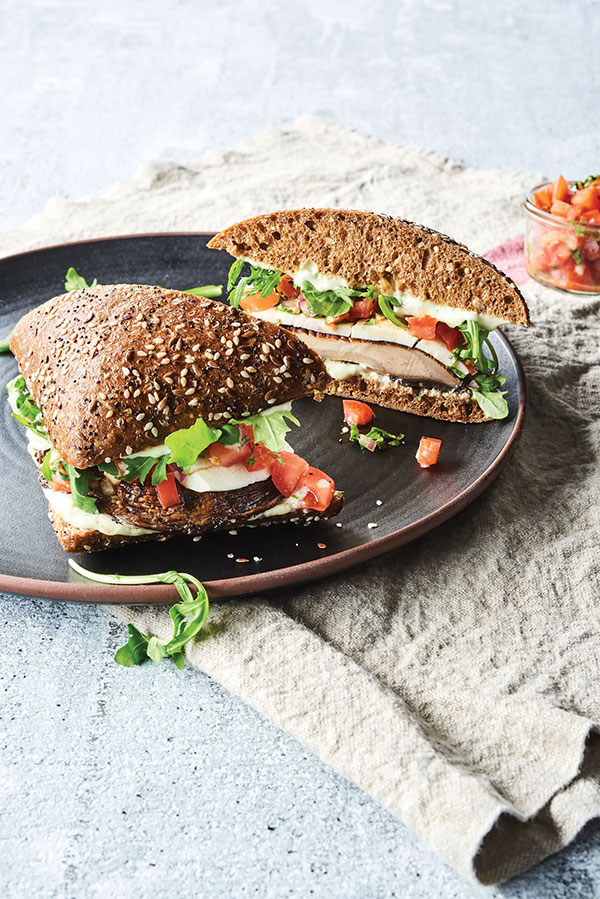
Portobello Mozzarella Sandwiches
Recipe courtesy of Aramark
Servings: 4
Tomato Bruschetta Topping:
- 1/4 pound fresh plum tomatoes, cored and diced
- 2 tablespoons red onion, peeled and minced
- 2 tablespoons fresh basil leaves, thinly sliced
- 1 teaspoon olive oil
- 1/4 teaspoon kosher salt
- 1 pinch ground black pepper
- 1 pinch fresh garlic, peeled and finely minced
Sandwiches:
- 1 pound fresh portobello mushrooms, cleaned, stems removed, sliced thin
- 3 tablespoons olive oil
- 1/4 teaspoon garlic powder
- 1/4 teaspoon kosher salt
- 1/8 teaspoon ground black pepper
- 1/4 cup mayonnaise
- 2 1/2 tablespoons prepared basil pesto
- 4 ciabatta rolls (4-by-4 inches), split in half
- 4 ounces fresh mozzarella cheese, sliced small
- 4 ounces tomato bruschetta topping
- 2 ounces fresh baby arugula
- 1/4 cup balsamic glaze
- To make tomato bruschetta topping: In bowl, combine tomatoes, onion, basil, olive oil, salt, pepper and garlic. Set aside.
- To make sandwiches: Preheat grill pan or grill to medium heat.
- Toss sliced mushrooms with olive oil, garlic powder, salt and pepper.
- Grill mushrooms until fork-tender, 3-4 minutes on each side. Let cool.
- Mix mayonnaise with pesto until combined. Spread 2 tablespoons pesto mayonnaise on cut sides of each roll.
- For each sandwich, layer 1/4 of grilled mushrooms, mozzarella slices, tomato bruschetta topping, arugula and balsamic glaze.
- Top with other roll halves. Cut diagonally in half to serve.
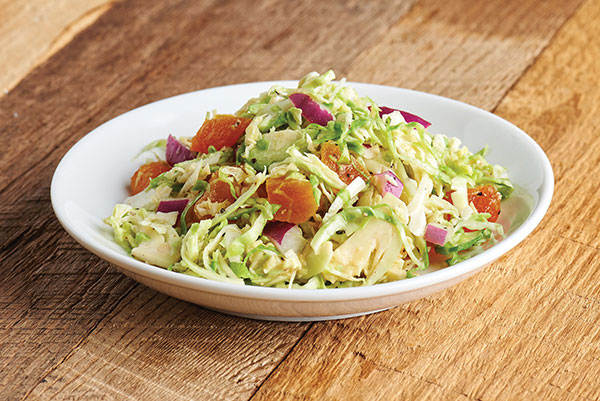
Apricot Brussels Sprouts Coleslaw
Recipe courtesy of Aramark
Servings: 4
- 2 tablespoons Dijon mustard
- 1 tablespoon honey
- 1 tablespoon granulated sugar
- 1 teaspoon salt
- 1 teaspoon ground black pepper
- 2 cups trimmed and shredded Brussels sprouts
- 1 cup dried apricot, diced
- 1 cup red onion, trimmed and diced
- Combine mustard, honey, sugar, salt and pepper. Mix well.
- Add Brussels sprouts, apricot and onion; toss to coat.
Aramark











